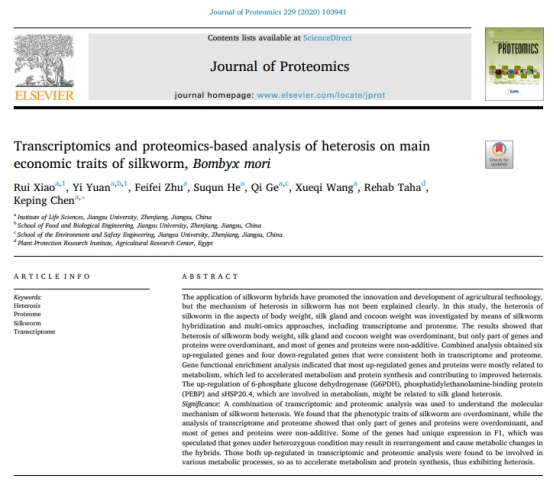Recently, the research group of Prof. Keping Chen from the School of Life Sciences, Jiangsu University published an article entitled "Analysis of transcriptome and proteomics of silkworm heterosis traits" in “Journal of Proteomics”.

Heterosis refers to the biological phenomenon that the hybrid F1 generation is superior to the homozygous parent in traits such as the resistance of disease, yield and quality, and is widely used in crop and animal breeding. However, its molecular mechanism has not been studied clearly.
There are many hypotheses about the genetic mechanism of heterosis, including hyperdominance hypothesis, dominant linked gene hypothesis, epistatic hypothesis, major gene hypothesis, genetic vibration synthesis theory, etc. The single-molecule heterosis model proposes a type of allelic interaction that leads to an increase in the activity of certain hybrid enzymes and thus affects heterosis. Bombyx mori is a good model organism for studying heterosis. Its larval stage is only 25 days and the breeding environment is easy to control.
Studies have shown that the level of heterosis is largely determined by the relationship between the beneficial and harmful genes, which are semi-dominant genes. In addition, the heterosis of single crosses is higher than that of double crosses and triple crosses, as well as the greater the genetic distance, the greater the heterosis. The greater the difference between parents, the greater the esterase activity of heterosis and the greater the possibility of heterosis. So far, understanding of the theoretical basis for silkworm heterosis is relatively weaker.
In this study, a low-yield line from China and a high-yield line from Japan were selected for cross-breeding to compare their weight of cocoon, shell and silk gland, as well as heterosis was evaluated. The combined analysis using transcriptomics and proteomics revealed the molecular mechanism of silkworm heterosis.
Original link: https://www.sciencedirect.com/science/article/pii/S1874391920303092?via%3Dihub